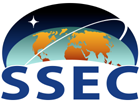4.1. ABI L1B Reader¶
The ABI Level 1B Reader operates on NOAA Level 1B (L1B) NetCDF files from the GOES-16 (GOES-East) and GOES-17/18 (GOES-West) Advanced Baseline Imager (ABI) instrument. The ABI L1B reader works off of the input filenames to determine if a file is supported by Geo2Grid. Files usually have the following naming scheme:
OR_ABI-L1b-RadF-M6C02_G18_s20223191830206_e20223191839514_c20223191839547.nc
These are the mission compliant radiance file naming conventions
used by the NOAA Comprehensive Large Array-data Stewardship
System (CLASS) archive and the CSPP GOES Rebroadcast (GRB) software.
The ABI L1B reader supports all instrument spectral bands, identified in
Geo2Grid as the products shown in the table below. The
ABI L1B reader can be provided to the main geo2grid.sh script
using the -r option and the reader name abi_l1b.
The list of supported products includes true and natural color imagery. These are created by means of a python based atmospheric Rayleigh scattering correction algorithm that is executed as part of the Geo2Grid ABI L1B reader, along with sharpening to the highest spatial resolution. For more information on the creation of RGBs, please see the RGB section.
Product Name |
Description |
|---|---|
C01 |
Channel 1 (0.47um) Reflectance Band |
C02 |
Channel 2 (0.64um) Reflectance Band |
C03 |
Channel 3 (0.86um) Reflectance Band |
C04 |
Channel 4 (1.37um) Reflectance Band |
C05 |
Channel 5 (1.6um) Reflectance Band |
C06 |
Channel 6 (2.2um) Reflectance Band |
C07 |
Channel 7 (3.9um) Brightness Temperature Band |
C08 |
Channel 8 (6.2um) Brightness Temperature Band |
C09 |
Channel 9 (6.9um) Brightness Temperature Band |
C10 |
Channel 10 (7.3um) Brightness Temperature Band |
C11 |
Channel 11 (8.4um) Brightness Temperature Band |
C12 |
Channel 12 (9.6um) Brightness Temperature Band |
C13 |
Channel 13 (10.3um) Brightness Temperature Band |
C14 |
Channel 14 (11.2um) Brightness Temperature Band |
C15 |
Channel 15 (12.3um) Brightness Temperature Band |
C16 |
Channel 16 (13.3um) Brightness Temperature Band |
true_color |
Ratio sharpened rayleigh corrected true color |
natural_color |
Ratio sharpened corrected natural color |
airmass |
Air mass RGB |
ash |
Ash RGB |
dust |
Dust RGB |
fog |
Fog RGB |
night_microphysics |
Night Microphysics RGB |
4.1.1. Command Line Usage¶
usage: geo2grid.sh -r abi_l1b -w <writer> [-h] [--clip-negative-radiances | --no-clip-negative-radiances]
4.1.1.1. ABI L1b Reader¶
- --clip-negative-radiances, --no-clip-negative-radiances
Clip negative radiances for IR bands. Default is to perform the clipping.
Default: True
Examples:
geo2grid.sh -r abi_l1b -h
geo2grid.sh -r abi_l1b -w geotiff --list-products -f /data/goes16/abi
geo2grid.sh -r abi_l1b -w geotiff --num-workers 8 -f /data/goes18/abi
geo2grid.sh -r abi_l1b -w geotiff -p C02 C03 C04 C05 C06 true_color -f OR_ABI-L1b-RadC*.nc
geo2grid.sh -r abi_l1b -w geotiff --ll-bbox -95.0 40.0 -85.0 50.0 -f OR_ABI-L1b-RadC*.nc
geo2grid.sh -r abi_l1b -w geotiff -p airmass dust --num-workers 4 --grid-configs=/home/g2g/my_grid.conf -g madison --method nearest -f /data/goes17/abi/
4.1.2. Product Explanation¶
4.1.2.1. True Color¶
The ABI L1b “true_color” composite produced by Geo2Grid provides a view of the Earth as the human eye would see it; or as close as we can come to with satellite data and the channels we have available. This means things like trees and grass are green, water is blue, deserts are red/brown, and clouds are white. The True Color image is an RGB (Red, Green, Blue) image consisting of the ABI C02 reflectance channel, a pseudo-green reflectance channel, and the ABI C01 reflectance channel. Each channel goes through a series of modifications to produce the final high quality image output by Geo2Grid.
The pseudo-green channel is a simple combination of 46.5% of C01, 46.5% of C02, and 7% of C03. While it is impossible to completely reproduce what a dedicated “green” channel on the ABI instrument would see, this method provides a good approximation while also limiting the computational requirements to produce it.
All bands involved in the true color composite have the Solar Zenith Angle Modification and Rayleigh Scattering Correction applied, except for C03 in the pseudo-green band where rayleigh correction is not applied due to the minimal effect it would have at that wavelength.
To improve the general spatial quality of the image, a Self Ratio Sharpening is also applied. Lastly, a Non-linear enhancement is applied.
4.1.2.2. C01 through C06¶
The Channel 1 through Channel 6 products are all reflectance channels on the ABI instrument. Besides the basic calibration necessary to convert the radiance values to reflectances, the data is passed through a square root function before being written to a grayscale image. The square root operation has the effect of brightening dark regions of the image.
For a more detailed explanation of these bands on the instrument, see the ABI Bands Quick Information Guides.
4.1.2.3. C07 and C11 through C16¶
These channels are all brightness temperature (infrared/IR) channels. To produce a grayscale image with dark land and white clouds, the data is inverted and scaled linearly in two segments. The first segment is from 163K to 242K, the second 242K to 330K. This is a common scaling used by the National Weather Service (NWS) for their AWIPS visualization clients.
For a more detailed explanation of these bands on the instrument, see the ABI Bands Quick Information Guides.
4.1.2.4. C08 through C10¶
These channels are also brightness temperature (infrared/IR) channels, but are scaled differently than those above. These are scaled linearly between 180K and 280K and then inverted. The inversion has the same effect of making land dark and clouds white.
For a more detailed explanation of these bands on the instrument, see the ABI Bands Quick Information Guides.
